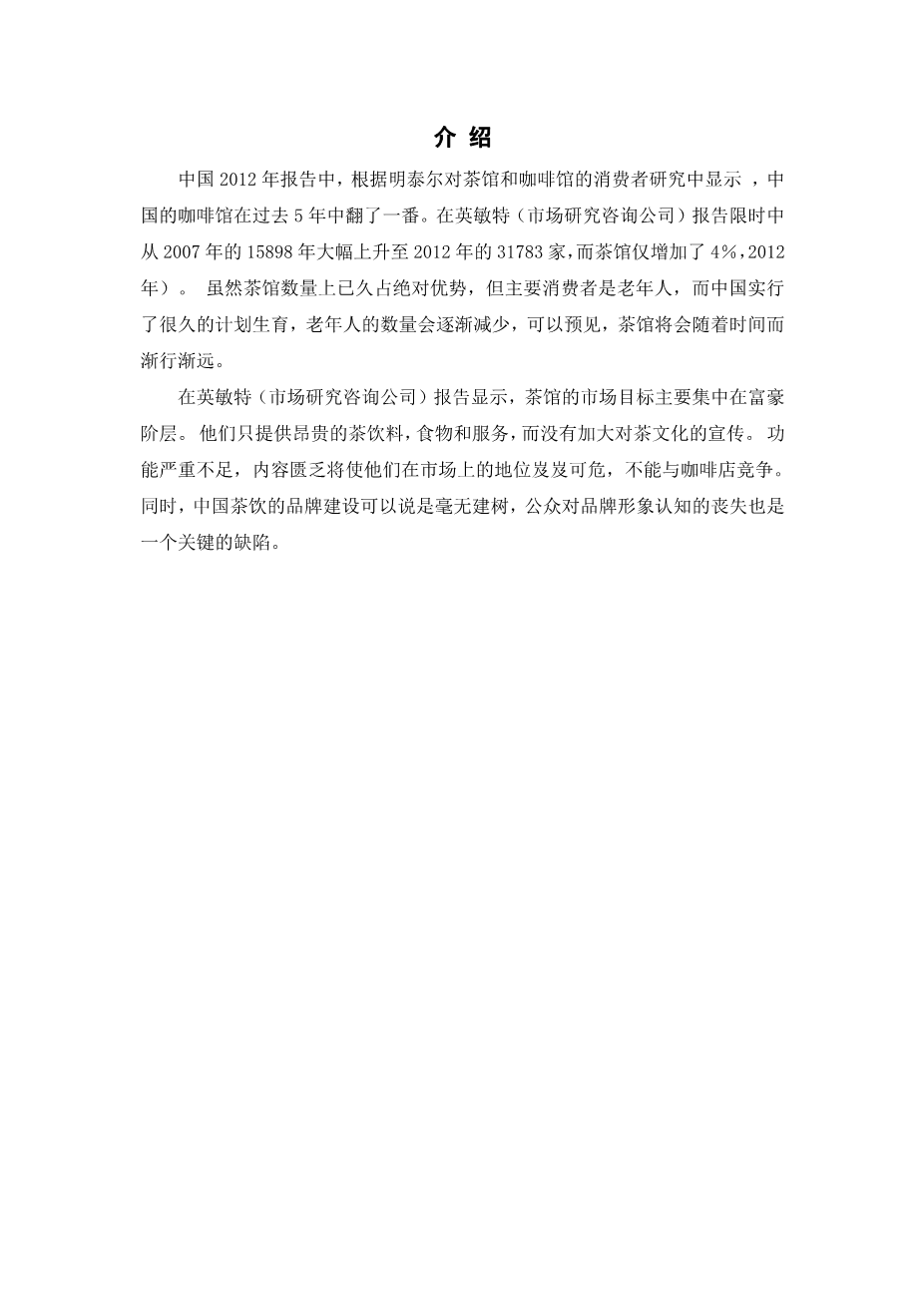|
|
ISSN 1923-841X [Print] |
|
International Business and Management |
ISSN 1923-8428 [Online] |
|
Vol. 12, No. 1, 2016, pp. 29-32 |
www.cscanada.net |
|
DOI:10.3968/8197 |
www.cscanada.org |
Starbucks VS Chinese Tea—Starbucks Brand Management Strategy Analysis in
China
YANG Qian[a],*; TU Xing[b]
[a]School of Applied Foreign Languages, Shenzhen Polytechnic, Shenzhen, Guangdong, China.
[b]College of Art and Design, Shenzhen University, Shenzhen, Guangdong, China.
*Corresponding author.
Received 30 November 2015; accepted 25 January 2016 Published online 29 February 2016
mainly focuses on the wealthy class. They offering expensive tea drinks, food and service (Mintel, 2012). The lacking of features will endanger their places in the market and cannot compete with coffee shops. Meanwhile, the loss of brand image cognition is a critical defect.
Abstract
As the worldrsquo;s largest coffee retailer, Starbucks coffee is the leading roaster and retailer of specialty coffee. Since it entered Chinese market in 1999, Starbucksrsquo; trademark of a green and white mermaid has been featured in more than 1700 outlets in China. Starbucks puts the customersrsquo; feeling and experience at the top of priority. It promotes a lsquo;Starbucks Culturersquo; value and emphases on “culture oriented” influence. Starbucksrsquo; success in China—a country with five thousands yearrsquo;s history of tea drinking is a classic profile of the international brand localization management.
Key words: Starbucks; Chinese tea; Marketing strategy; Brand management; Culture cognition
Yang, Q . , amp; Tu, X . (2016) . Starbucks VS Chinese Tea —
Starbucks Brand Management Strategy Analysis in China.
International Business and Management, 12 (1), 29-32. Available from: http://www.cscanada.net/index.php/ibm/article/view/8197 DOI: http://dx.doi.org/10.3968/8197
INTRODUCTION
According to the Mintel consumer research-Teahouses and coffeehouses-China report in 2012, the coffeehouses in China have doubled in the past 5 years. From 15898 in 2007 increased sharply to 31783 in 2012 while the teahouses raised 4% only with the number of 50,000 (Mintel, 2012). Though the teahouses are superior in numbers, the main consumers are the elders, which can be predicted that teahouses will experience recession in the future.
The report shows, the market target of tea houses
1. THE SUCCESS OF STARBUCKS
Established in 1971 in Seattle, Washington, U.S.A. It started its first small coffeehouse lsquo;Tea and Spicersquo; owned by three men—Jerry Baldwin, Zev Siegel, and Gordon
Bowker, which mainly offered professional coffee knowledge, and taught customers how to make fine coffee at home. The company took the name of the chief mate in the book Moby-Dick: Starbuck, after considering “Cargo House” and “Pequod” (Time Out, 2011). Howard Schultz bought the original Starbucks franchise in 1987 and named as Starbucks Corporation (The Daily Telegraph, 2011). From then on, Starbucks changed into a coffee chain from being a small coffee bean retailer. Now Starbucks Coffee Company is North Americarsquo;s leading roaster and retailer of specialty coffees. Sales have climbed an average of 20% annually since the company went public in 1992 with total stores of 162 while profit bounded ahead average of 30% per year (Wu, 2009). As of June 28, 2015, Starbucks owns 22,519 store worldwide, and was awarded most ethical company 2015. (Starbucks, 2016a)
The company has demonstrated rapid growth for over a decade, and is continuing to grow profitably through the current recessionary environment. In January 1999, Starbucks entered Beijing, and in May 2000, many of its branches began to appear in the financial capital of China, Shanghai. It has become the leading brand in inland China coffee industry currently.
2. THE DEVELOPMENT OF STARBUCKS
IN CHINA
It is well known that China is the origin country of tea.
29 Copyright copy; Canadian Research amp; Development Center of Sciences and Cultures
Starbucks VS Chinese Tea—Starbucks Brand Management Strategy Analysis in
China
There is a long history of tea drinking in China. Although it is difficult to ascertain when the tea-drinking culture started exactly, there are evidences showing that the habit of tea drinking in many countries was spread from China.
Since the beginning of China boom in the last decade, foreign drinks such as coffee and coke are becoming popularity among youth in China. Coffee is gradually relative to taste and fashion, and it becomes a way to show social status. This country has represented an attractive potential market for international coffee chains. Nowadays, the omnipresence of coffee shops on the streets of many Chinese cities mentioned as an example of Chinarsquo;s growing taste of foreign food and drink. Young people become fans of coffee. For many Chinese, coffee is an inseparable part of life now.
In some large cities like Beijing, Guangzhou or Shanghai, the coffee consumption can be amazing. China, with its strong tea culture is becoming a huge potential market for coffee brands.
Starbuckrsquo;s China has experienced a notable growth since opening its first store in Beijingrsquo;s China World Trade Center in the year of 1999. Now, Starbucksrsquo; trademark of a green and white mermaid has been featured in more than 1,900 outlets in 99 cities with 30,000 staff in China (Starbucks, 2016b). Starbucks saw a 30% year- over-year jump in revenues f
剩余内容已隐藏,支付完成后下载完整资料


英语译文共 10 页,剩余内容已隐藏,支付完成后下载完整资料
资料编号:[613367],资料为PDF文档或Word文档,PDF文档可免费转换为Word
您可能感兴趣的文章
- 饮用水微生物群:一个全面的时空研究,以监测巴黎供水系统的水质外文翻译资料
- 步进电机控制和摩擦模型对复杂机械系统精确定位的影响外文翻译资料
- 具有温湿度控制的开式阴极PEM燃料电池性能的提升外文翻译资料
- 警报定时系统对驾驶员行为的影响:调查驾驶员信任的差异以及根据警报定时对警报的响应外文翻译资料
- 门禁系统的零知识认证解决方案外文翻译资料
- 车辆废气及室外环境中悬浮微粒中有机磷的含量—-个案研究外文翻译资料
- ZigBee协议对城市风力涡轮机的无线监控: 支持应用软件和传感器模块外文翻译资料
- ZigBee系统在医疗保健中提供位置信息和传感器数据传输的方案外文翻译资料
- 基于PLC的模糊控制器在污水处理系统中的应用外文翻译资料
- 光伏并联最大功率点跟踪系统独立应用程序外文翻译资料



